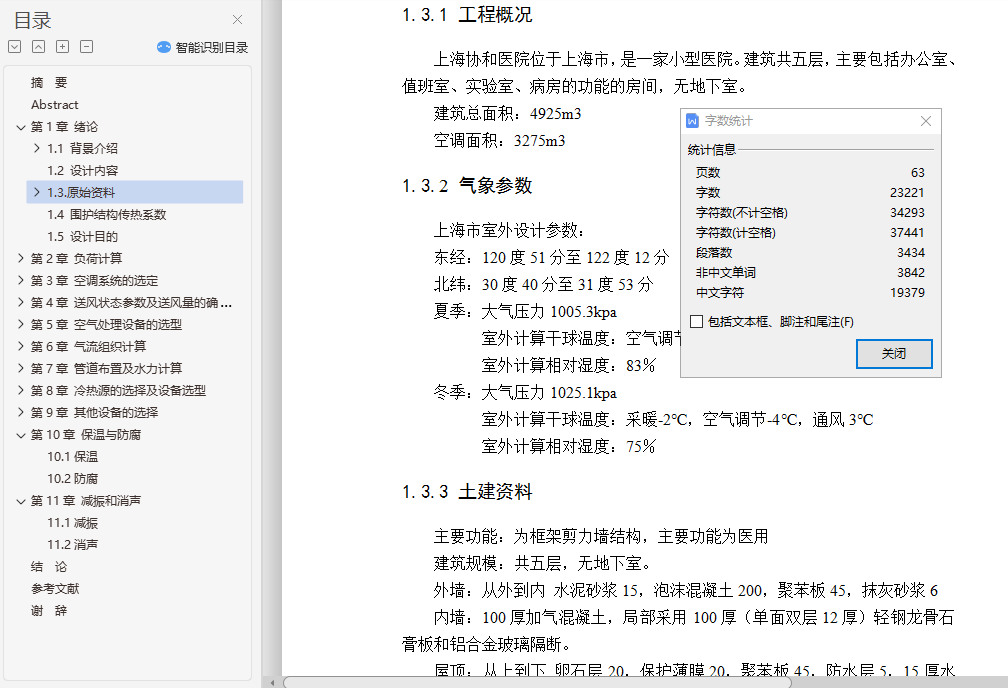摘 要
本设计为上海协和医院空调通风系统设计。
系统主要采用风机盘管承担空调房间的冷负荷与热负荷,每个房间的吊顶内安置风机盘管。新风则通过独立的新风管道先送入风机盘管,再与回风混合一起送入房间。新风机组吊顶安装,每一层楼安装一台新风机组负担该层所有空调房间的新风负荷。该空调系统的优点是占用建筑面积少,可集中供冷和供热;同时各末端装置有独立的开关和调节功能,各房间的温度可独自调节与控制,并且防止了空气的交叉感染。空调水系统采用闭式系统,因为它除了不易污染,节省初投资外,还具有很大的节能效果。
本设计内容包括:空调冷负荷、热负荷计算;空调系统的确定及论证;送风状态参数及送风量的确定;气流组织计算;空气处理设备的选型;冷热源的选择管径选取及水力计算;风管水力计算;及设备选型;其他设备的选择;保温与防腐以及减振和消声等内容。
关键词 空调通风;医院;风机盘管加新风系统;冷热源
Abstract
The program for the air conditioning and ventilation system design of Shanghai Xiehe hospital.
Cooling load and thermal load system mainly adopt fan-coil unit assume air conditioning room, each room fan coil placed inside the ceiling. Fresh air into the fan coil first through independent air pipes, and the air mixed together into the room. Installation of ceiling air supply unit, the wind load on each floor to install a fresh air unit burden the layer of all air conditioning rooms. The advantages of the air conditioning system is reduce the building area, central cooling and heating; and the terminal device is independent of the switch and the regulating function, the room temperature can be adjusted alone and control, and to prevent cross infection in the air. The closed system of air conditioning water system uses, because in addition to its not easy to pollution, save the initial investment, but also has great energy-saving effect.
The design includes: the cooling load, heat load calculation and demonstration; air conditioning system; air state parameters and determine the air flow rate of air flow organization; calculation; selection of air treatment equipment; selection of pipe diameters of cold and heat source selection and hydraulic calculation of wind pipe; hydraulic calculation; and selection of equipment; equipment selection; heat preservation and anti-corrosion and vibration and noise etc..
Keywords Air conditioning and ventilation; Hospital; fan coil plus fresh air system; cold and heat source
目 录
摘 要 I
Abstract II
第1章 绪论 1
1.1 背景介绍 1
1.1.1 选题背景 1
1.2 设计内容 1
1.3.原始资料 2
1.3.1 工程概况 2
1.3.2 气象参数 2
1.3.3 土建资料 2
1.4 围护结构传热系数 3
1.5 设计目的 3
第2章 负荷计算 4
2.1负荷概念 4
2.2冷负荷的计算 4
2.2.1 围护结构逐时传热形成的冷负荷 4
2.2.2 透过玻璃窗的日射得热形成冷负荷的计算方法 5
2.2.3 照明散热形成的冷负荷 5
2.2.4 人员散热形成的冷负荷 6
2.3 热负荷的计算 7
2.3.1 建筑围护结构的基本耗热量 7
2.3.2附加耗热量 8
2.3.3 门窗缝隙渗入冷空气的耗热量 9
2.4 湿负荷的计算 10
2.4.1 人体散湿量 10
2.4.2 敞开水面的散湿量 10
2.5 新风负荷的计算 10
2.6 房间负荷的计算 11
2.6.1骨龄检测室冷负荷计算 11
第3章 空调系统的选定 16
3.1 空调系统的分类 16
3.1.1 空调系统的分类 16
3.1.1 空调系统的分类 16
3.1.2空调水系统的分类 16
3.2 本次设计的方案 18
3.3风机盘管加新风系统与空气-水诱导器系统的比较 18
3.4几种新风送风方式的比较 18
3.4结论 19
第4章 送风状态参数及送风量的确定 20
4.1新风量的规定 20
4.2风机盘管系统风量的计算 20
4.2.1风机盘管的夏季处理过程 20
4.2.2风机盘管的冬季处理过程 21
第5章 空气处理设备的选型 23
5.1风机盘管的选型 23
5.2新风机组的选型 25
第6章 气流组织计算 27
6.1气流组织概述 27
6.2风口形式的确定 27
6.2气流组织形式的确定 27
6.3气流组织计算 28
第7章 管道布置及水力计算 42
7.1空调水系统的水力计算 42
7.1.1水管管径的确定 42
7.1.2阻力的确定 42
7.1.3设计步骤 43
7.1.4水系统的水力计算 44
7.2风管的水力计算 44
7.2.1风管系统 44
7.2.2风管水力计算的内容 44
7.2.3计算方法 45
第8章 冷热源的选择及设备选型 46
8.1冷源的选择 46
8.2热源的选择 46
8.3机组选型 47
8.3.1冷水机组 47
8.3.2换热器 48
第9章 其他设备的选择 50
9.1冷却塔的选择 50
9.1.1冷却塔选择事项 50
9.1.2冷却塔选择事项 50
9.2水泵的选择 51
9.2.1选择事项 51
9.2.2循环水泵的选择 51
9.2.3冷却水泵的选择 52
9.3膨胀水箱的选择 52
9.3.1膨胀水箱水量的计算 52
9.3.2膨胀水箱的选型 52
9.3.2系统的补水 53
第10章 保温与防腐 54
10.1保温 54
10.2防腐 54
第11章 减振和消声 55
11.1减振 55
11.2消声 55
结 论 57
参考文献 58
谢 辞 59




